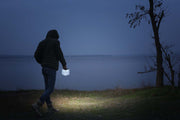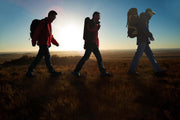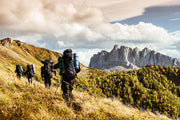Night Hiking Tips and Tricks

Hiking is an activity that can be enjoyed at any time of the day, but there's something special about hitting the trails after dark. Night hiking can be a thrilling and unique experience, but it's important to take the proper precautions to ensure your safety. In this article, we'll cover some safety tips, types of trails to hike at night, hazards to be aware of, and items you may want to bring along for your next night hike.
Safety Tips
Before you head out on a night hike, it's important to take some safety precautions. Here are some tips to keep in mind:
- Always hike with a buddy or group. If you're hiking alone, let someone know where you'll be and what time you expect to return.
- Bring a headlamp or flashlight, even if you don't plan on using them. You never know when you might need them, and they can be lifesavers in an emergency.
- Wear reflective clothing or accessories so that you can be easily seen by others.
- Stick to well-marked trails that you're familiar with. It can be easy to get disoriented in the dark, so it's best to stick to familiar territory.
- Stay hydrated and bring snacks to keep your energy up.
Types of Trails to Hike at Night
Some trails are better suited for night hiking than others. Here are some types of trails to consider:
- Urban trails: Trails in well-lit, populated areas can be a good option for night hiking. You'll be less likely to encounter wildlife, and you'll have access to amenities like restrooms and water fountains.
- Full moon hikes: Hiking during a full moon can be a unique and beautiful experience. Full moon hikes are often organized by parks and nature centers, so look for events in your area.
- Familiar trails: If you're new to night hiking, it's best to stick to trails that you're already familiar with. This will help you avoid getting lost or disoriented in the dark.
Hazards to Be Aware Of
Night hiking comes with its own set of hazards. Here are some things to be aware of:
- Wildlife: Animals are more active at night, so it's important to be aware of your surroundings. Bring bear spray if you're in an area with bears or other large animals.
- Tripping hazards: It can be hard to see rocks, roots, and other tripping hazards in the dark. Take it slow and use your light to scan the trail ahead.
- Temperature drops: Temperatures can drop significantly at night, so be prepared with appropriate clothing layers.
Items to Bring Along
Here are some items you may want to bring along for your next night hike:
- Portable Light is essential for night hiking.Try a solar light by Solight Design.
- Solar lanterns from Solight Design: These lanterns are lightweight, packable, and solar-powered. They're perfect for night hiking because they provide a soft, ambient light that won't disturb wildlife or other hikers.
- Extra layers: Be prepared for temperature drops by bringing extra layers of clothing.
- Snacks and water: Stay hydrated and energized with plenty of snacks and water.
Night Hiking Final Thoughts
Night hiking can be an exciting and unique way to experience the trails, but it's important to take the proper precautions. Stick to well-marked trails, bring a buddy, and be aware of your surroundings. With the right equipment and mindset, you'll be ready to hit the trails after dark.






Leave a comment